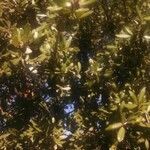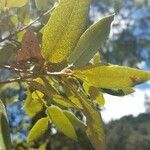Trees or shrubs , trees small to medium-sized, to 25 m, shrubs of variable size. Twigs branching at 60° angles or less, golden brown, 1-2 mm diam., flexible, densely pubescent 1st year, moderately so 2d year. Terminal buds conic, 2-8 mm, scales brown with ciliate margins. Leaves: petiole 3-14 mm, rusty-pubescent, adaxially flattened. Leaf blade oblong, acuminate, usually flat to slightly concave, 20-70 × 10-35 mm, thick, leathery, base obtuse to rounded, secondary veins 12 or more pairs, branching at ca. 50° angles, slightly raised abaxially, margins often slightly revolute with moderately thickened cell walls, entire to spinulose-dentate (especially on juvenile growth), regularly toothed, teeth terminating with mucronate to spinescent tip, apex acute or obtuse, mucronate to spinescent; surfaces abaxially glabrate to pubescent with bluish white wax layer, often obscured by golden glandular and multiradiate hairs, adaxially yellowish green, scurfy with multiradiate hairs, later in season slightly pubescent. Acorns solitary or paired, rarely in 3s or 4s; cup saucer-shaped, 4-10 mm deep × 15-40 mm wide, rims often corky and thickened, scales appressed, deeply embedded in tomentum, often appearing swollen and keeled, tuberculate; nut ovoid, 15-30 × 10-20 mm, apex blunt, glabrous; nut scar 4-10 mm diam.
More
An evergreen tree. It grows 21 m high and spreads 9 m wide. It has a spreading crown. The bark is thick and smooth. It is grey-brown but tinged with red. The leaves are oval and have spiny teeth along the edge. They are downy. The fruit are acorns. They are almost without stalks.
Found in a variety of habitats, often as the dominant species, it is a tall tree in deep, cool, narrow canyons and is a low thicket-forming shrub on high windswept slopes; at elevations from 200-2,700 metres.
More
It is a temperate plant. It suits hardiness zones 7-10.



